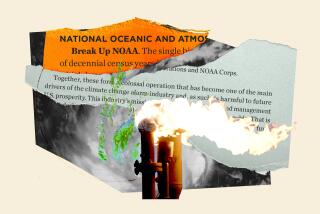Op-Ed: Here’s how the U.S. military can better fight the ‘existential threat’ of climate change

Secretary of Defense Lloyd J. Austin III declared global warming an existential threat to U.S. national security at a White House climate summit earlier this year. Using language normally applied to conventional adversaries like China and Russia, Austin described the climate crisis as “a profoundly destabilizing force for our world,” generating widespread havoc and bloodshed.
If we take his assessment at his word, the Department of Defense will have to mobilize its capabilities as if preparing for a major war — altering its priorities and operations and hardening its military bases against extreme climate effects.
This will prove no easy task. The Pentagon is the nation’s leading institutional consumer of fossil fuels and the single largest institutional producer of greenhouse gases in the world. In 2020, for example, the U.S. armed forces were responsible for approximately 52 million metric tons in carbon dioxide emissions — more than was emitted by some entire countries, such as Norway, Sweden and Switzerland.
Clearly, the U.S. cannot reduce its national greenhouse gas emissions rapidly without a sustained drive by the Pentagon to abandon carbon-based fuels in favor of renewable energy. Of course, the technologies it must develop to achieve such advances would have widespread application to the civilian economy as well.
The benefits to America’s future — and the world’s — would be broad. But it all depends on whether the Pentagon leadership is serious about treating climate change as an existential threat and acting accordingly.
Only in recent years has the military begun to consider climate change in its operations — focusing on how this crisis affects its bases, since some of its major coastal installations are under threat from rising seas, severe storms and persistent flooding.
In recognition of these perils, the Defense Department finally identified global warming as a national security concern in 2010. Climate change, its Quadrennial Defense Review stated, “could have significant geopolitical impacts around the world,” while also jeopardizing the utility of key bases at home.
That year, for the first time, the department adopted specific objectives for wide reductions in fossil fuel use and greenhouse gas emissions. Under its Strategic Sustainability Performance Plan for 2010, the department pledged to reduce petroleum use by its nontactical vehicle fleets by 30% by 2020 relative to 2005. The plan also included the objective of reducing greenhouse gas emissions at U.S. military installations and their energy suppliers by 34% relative to 2008.
Over the next 10 years, the department made impressive efforts to fulfill these objectives, replacing 44% of its petroleum-fueled vehicles with hybrids and all-electric cars and building massive solar arrays to generate electricity for its bases. In 2020, the Pentagon stated it reduced petroleum use by 41% relative to 2005 and cut greenhouse gas emissions by 23% relative to 2008.
But, crucially, these targets did not apply to ships, aircraft and combat vehicles — almost all of which continue to be powered by petroleum and remain a major source of greenhouse gases. Jet fuel for military planes is a huge emitter. A B-2 bomber, for example, uses 4.2 gallons of fuel to travel just one nautical mile; a single air mission puts hundreds of tons of carbon dioxide into the atmosphere.
During Donald Trump’s presidency, talk of climate change largely disappeared from official Pentagon statements and the sense of urgency in resisting it seemed to dissipate as senior officers began to emphasize the growing threats from China and Russia. Now, with Joe Biden in the White House and Austin at the Pentagon, climate change has again been identified as a major security threat, one that requires a full-scale response.
However, the Pentagon has yet to outline specific actions or objectives that would include far greater reductions in fossil fuel use and greenhouse gas emissions than its 2010 sustainability plan included. If climate change poses an “existential” threat, it is imperative that these goals be extended to tactical as well as nontactical military vehicles. Additionally, all U.S. military installations should be required to obtain all of their primary energy from renewable sources by 2035.
Mobilization on this scale would require a major allocation of Defense funds and resources. This is not beyond the Pentagon’s capabilities, given that it was able to reduce its petroleum consumption and greenhouse gas emissions between 2010 and 2020.
With access to the world’s largest research budget, the department and its top scientists have the capacity to create the technologies needed to achieve major breakthroughs in green energy and transportation — technologies that could be adopted broadly.
The Defense Advanced Research Projects Agency, known as DARPA, could take the lead. The agency has helped develop advancements such as GPS, the internet and artificial intelligence. It recently began a program called Reefense to use reefs, natural features and engineered structures to protect 1,700 department-managed military facilities that are threatened by sea level rise and coastal flooding from increased storms and wave action.
The Defense Department now needs to go beyond preparing for the consequences of climate change to being a leader in developing broad-based technologies to reduce global warming. It has the financial resources and scientific expertise to take on this challenge. Now the order must be given.
Michael Klare is professor emeritus of peace and world security studies at Hampshire College and the author of “All Hell Breaking Loose: The Pentagon’s Perspective on Climate Change.”
More to Read
A cure for the common opinion
Get thought-provoking perspectives with our weekly newsletter.
You may occasionally receive promotional content from the Los Angeles Times.










